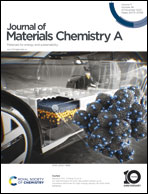Enhancing energy transfer by regulating electron transport pathways in semiconductor metal–organic frameworks†
Abstract
Photocatalysis is an effective approach to convert solar energy into chemical energy using semiconductor materials. However, the fast recombination rate of electron–hole pairs in these materials leads to low energy utilization efficiency and poor photocatalytic performance. Herein, an iron-based Metal–Organic Framework (Fe-MOF) was constructed via structural tailoring, which has structural advantages such as a one-dimensional Fe–O-triazole chain and strong π–π stacking interaction, ensuring a broad absorption range, high electron conductivity (5.53 × 10−4 S m−1), and good photogenerated electron–hole separation efficiency. Fe-MOF as a photosensitizer could facilitate the efficient degradation of tetracycline hydrochloride (TC) under visible light irradiation (e.g., 40 ml of 350 mg L−1 TC showed over 99% degradation in 5 minutes with 5 mg Fe-MOF as the photocatalyst). As a comparison, Zn-MOF, which is isomorphic to Fe-MOF, was prepared using crystal engineering and its photodegradation efficiency was greatly reduced. The results provide a design basis for the development of light harvesting in artificial photosynthesis.

- This article is part of the themed collection: Journal of Materials Chemistry A HOT Papers


 Please wait while we load your content...
Please wait while we load your content...